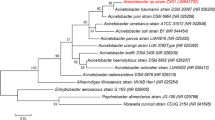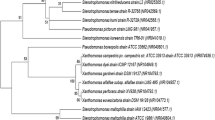Abstract
An enrichment culture technique was used for the isolation of bacteria capable of utilizing fipronil as a sole source of carbon and energy. Based on morphological, biochemical characteristics and phylogenetic analysis of 16S rRNA sequence, the bacterial strains were identified as Acinetobacter calcoaceticus and Acinetobacter oleivorans. Biodegradation experiments were conducted in loamy sand soil samples fortified with fipronil (50 µg kg−1) and inoculated with Acinetobacter sp. cells (45 × 107 CFU mL−1) for 90 days. Soil samples were periodically analyzed by gas liquid chromatography equipped with electron capture detector. Biodegradation of fipronil fitted well with the pseudo first-order kinetics, with rate constant value between 0.041 and 0.051 days−1. In pot experiments, fipronil and its metabolites fipronil sulfide, fipronil sulfone and fipronil amide were found below quantifiable limit in soil and root, shoot and leaves of Zea mays. These results demonstrated that A. calcoaceticus and A. oleivorans may serve as promising strains in the bioremediation of fipronil-contaminated soils.
Similar content being viewed by others
Abbreviations
- CFU mL−1 :
-
Colony forming unit per mililitre
- w/w:
-
Weight/weight
- w/v:
-
Weight/volume
- WHC:
-
Water holding capacity
- C0 :
-
Maximum concentration
- C:
-
Concentration at time t
- t:
-
Treatment times in days
- t0 :
-
Treatment time of maximum concentration in days
- k:
-
Degradation rate constants (days−1)
References
Aajoud A, Ravanel P, Tissut M (2003) Fipronil metabolism and dissipation in a simplified aquatic ecosystem. J Agric Food Chem 51:1347–1352
Abhilash PC, Srivastava S, Srivastava P, Singh B, Jafri A, Singh N (2011) Influence of rhizospheric microbial inoculation and tolerant plant species on the rhizoremediation of lindane. Environ Exp Bot 74:127–130
Barghouthi SA (2011) A universal method for the identification of bacteria based on general PCR primers. Indian J Microbiol 51:43–44
Benimeli CS, Fuentes MS, Abate CM, Amoroso MJ (2008) Bioremediation of lindane contaminated soil by Streptomyces sp. M7 and its effects on Zea mays growth. Int Biodeterior Biodegrad 61:233–239
Bobe A, Coste CM, Cooper JF (1997) Factors influencing the adsorption of fipronil in soils. J Agric Food Chem 45:4861–4865
Bonmatin JM, Giorio C, Girolami V, Goulson D, Kreutzweiser DP, Krupke C, Liess M et al (2015) Environmental fate and exposure; neonicotinoids and fipronil. Environ Sci Pollut Res 22:35–67
Chopra I, Chauhan R, Kumari B, Dahiya KK (2011) Fate of fipronil in cotton and soil under tropical climatic conditions. Bull Environ Contam Toxicol 86:242–245
Cole LM, Nicholson RA, Casida JE (1993) Action of phenyl pyrazole insecticide at the GABA-gated chloride channel. Pestic Biochem Physiol 46:47–54
Das P, Mukherjee S, Sen R (2008) Genetic regulations of the biosynthesis of microbial surfactants: an overview. Biotechnol Genet Eng 25:165–186
Gunasekara AS, Troung T, Goh KS, Spurlock F, Tjeerdema RS (2007) Environmental fate and toxicology of fipronil. J Pestic Sci 32(3):189–199
Holt GJ (1994) Bergey’s manual of determinative bacteriology, 3rd edn. Williams and Wilkins, Baltimore
Huang L, Xie J, Lv BY, Shi XF, Li GQ, Liang FL, Lian JY (2013) Optimization of nutrient component for diesel oil degradation by Acinetobacter beijerinckii ZRS. Mar Pollut Bull 76:325–332
Ibrahim SI, Abdel Lateef MF, Khalifa HMS, Abdel Monem AE (2013) Phytoremediation of atrazine-contaminated soil using Zea mays (maize). Ann Agric Sci 58:69–75
Johnson DL, Maguirea KL, Andersonb DL, McGrath SP (2004) Enhanced dissipation of chrysene in planted soil: the impact of rhizobial inoculums. Soil Biol Biochem 36:33–38
Kuiper I, Lagendijk EL, Bloemberg GV, Lugtenberg BJJ (2004) Rhizoremediation: a beneficial plant–microbe interaction. Mol Plant Microbe Interact 17:6–15
Kumar R, Singh B, Gupta VK (2012) Biodegradation of fipronil by Paracoccus sp. in different types of soil. Bull Environ Contam Toxicol 88:781–787
Lin K, Haver D, Oki L, Gan J (2008) Transformation and sorption of fipronil in urban stream sediments. J Agric Food Chem 56:8594–8600
Lynch JM, Whipps JM (1990) Substrate flow in the rhizosphere. Plant Soil 129:1–10
Mandal K, Singh B, Jariyal M, Gupta VK (2013) Microbial degradation of fipronil by Bacillus thuringiensis. Ecotoxicol Environ Saf 93:87–92
Mandal K, Singh B, Jariyal M, Gupta VK (2014) Bioremediation of fipronil by a Bacillus firmus isolate from soil. Chemosphere 101:55–60
Masutti CSM, Mermut AR (2007) Degradation of fipronil under laboratory conditions in a tropical soil from Sirinhaem Pernambuco, Brazil. J Environ Sci Health Part B 42:33–43
Mohapatra S, Deepa M, Jagdish GK, Rashmi N, Kumar S, Prakash GS (2010) Fate of fipronil and its metabolites in/on grape leaves, berries and soil under semi arid tropical climatic conditions. Bull Environ Contam Toxicol 84:587–591
Paliwal R, Uniyal S, Rai JPN (2014) Evaluating the potential of immobilized bacterial consortium for black liquor decolorization and delignification. Environ Sci Pollut Res 22(9):6842–6853
Park JH, Feng Y, Ji P, Voice TC, Boyd SA (2003) Assessment of bioavailability of soil-sorbed atrazine. Appl Environ Microbiol 69(6):3288–3298
Read DB, Bengough AG, Gregory PJ, Crawford JW, Robinson D, Scrimgeour CM, Young IM, Zhang K, Zhang X (2003) Plant roots release phospholipid surfactants that modify the physical and chemical properties of soil. New Phytol 157:315–326
Saitou N, Nei M (1987) The neighbor-joining method: a new method for reconstructing phylogenetic trees. Mol Biol Evol 4:406–425
Smith SC, Ainsworth CC, Traina SJ, Hicks RJ (1992) Effect of sorption on the biodegradation of quinoline. Soil Sci Soc Am J 56:737–746
Thangadurai P, Suresh S (2014) Biodegradation of endosulfan by soil bacterial cultures. Int Biodeterior Biodegrad 94:38–47
Tingle CC, Rother JA, Dewhurst CF, Lauer S, King WJ (2003) Fipronil: environmental fate, ecotoxicology, and human health concerns. Rev Environ Contam Toxicol 176:1–66
Uniyal S, Rawat M, Rai JPN (2013) Cadmium biosorption by Stenotrophomonas humi and Micrococcus luteus: kinetics, equilibrium and thermodynamic studies. Desalin Water Treat 51:1–13
Uniyal S, Paliwal R, Sharma RK, Rai JPN (2016) Degradation of fipronil by Stenotrophomonas acidaminiphila isolated from rhizospheric soil of Zea mays. 3 Biotech 6:48. doi:10.1007/s13205-015-0354-x
Wang SN, Liu Z, Xu P (2009) Biodegradation of nicotine by a newly isolated Agrobacterium sp. strain S33. J Appl Microbiol 107:838–847
Wang G, Yue W, Liu Y, Li F, Xiong M, Zhang H (2013) Biodegradation of the neonicotinoid insecticide Acetamiprid by bacterium Pigmentiphaga sp. strain AAP-1 isolated from soil. Bioresour Technol 138:359–368
Ying GG, Kookana R (2002) Laboratory and field studies on the degradation of fipronil in a soil. Aust J Soil Res 40:1095–1110
Zhu G, Wu H, Guo J, Kimaro FME (2004) Microbial degradation of fipronil in clay loam soil. Water Air Soil Pollut 153:35–44
Acknowledgments
Laboratory facilities of G. B. Pant University of Agriculture & Technology, Pantnagar and Inspire Fellowship to Shivani Uniyal from Department of Science and Technology, New Delhi are thankfully acknowledged.
Author information
Authors and Affiliations
Corresponding author
Rights and permissions
About this article
Cite this article
Uniyal, S., Paliwal, R., Verma, M. et al. Isolation and Characterization of Fipronil Degrading Acinetobacter calcoaceticus and Acinetobacter oleivorans from Rhizospheric Zone of Zea mays . Bull Environ Contam Toxicol 96, 833–838 (2016). https://doi.org/10.1007/s00128-016-1795-6
Received:
Accepted:
Published:
Issue Date:
DOI: https://doi.org/10.1007/s00128-016-1795-6




